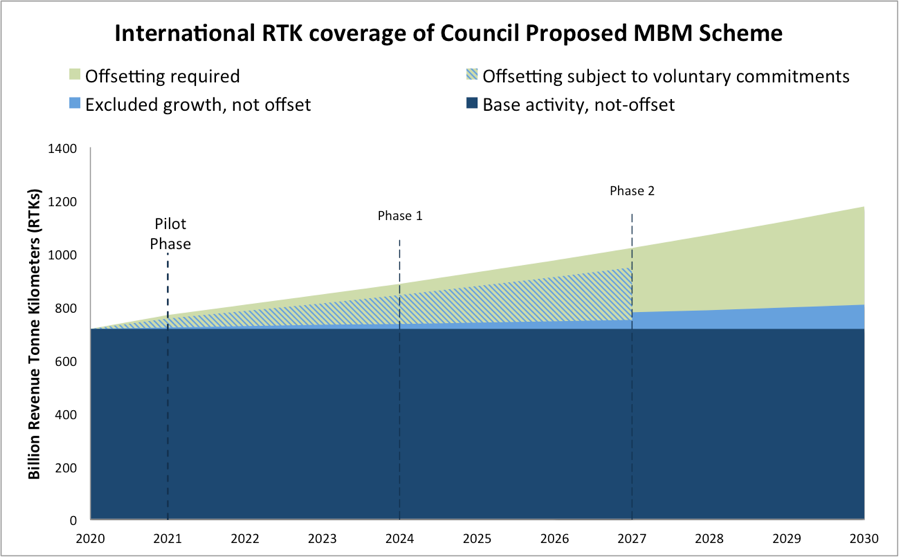Is carbon neutral growth on the horizon for aviation? That depends on your definition
Blog
Reading the tea leaves in ICAO’s market-based measure
News is flying fast and furious from Montreal these days about the development of ICAO’s market-based measure (MBM) for offsetting emissions growth from international aviation. Following last week’s Friends of the President and ICAO Council meetings, revised MBM text has been posted on the website for the upcoming 39th Assembly, which may mark the decision point following 15 years of work. Previous ICCT analysis of the MBM’s coverage of carbon neutral growth (CNG) can be found here, with a more comprehensive analysis of the full MBM available here.
The new text includes some changes to the recommended MBM that impact the coverage of the system. Most significantly, it pushes back mandatory offsetting from 2021 to 2027 and introduces two new three year voluntary phases spanning 2021 to 2026. The text also allows for countries that volunteer to join these initial phases to subsequently opt out, provided they give at least six months’ notice. How much post-2020 growth will be offset* now depends upon which countries opt into the initial voluntary phases. After becoming mandatory in 2027, the system will exempt about 90 of the poorest states (LDCs, SIDS, and LLDCs) accounting for roughly 7% of international revenue tonne kilometers (RTKs) entirely, along with states accounting for less than 0.5% of global RTKs individually and 90% on a cumulative basis. Other changes include defining CNG based upon the average of 2019 and 2020 emissions rather than 2020 emissions (a small increase in coverage, modeled below), and allowing nations to direct their airlines to offset future emissions based upon 2020 levels rather than a future year’s emissions during the three year pilot phase (a decrease in coverage, not yet modeled).
The wedge chart below summarizes our latest estimate of what share of future international RTKs will need to be offset under the proposed MBM. (For simplicity, we focus here on traffic coverage rather than emissions, taking advantage of the fact that the two are correlated at the system level.) Excluded pre-2020 traffic is shown in dark blue, post-2020 growth requiring offsetting based upon the current mandatory text (2027+) and likely country opt-ins (2021 to 2026) are shown in green, and growth not subject to offsetting shown in light blue. Here, we assume that the U.S., Canada, Mexico, 44 members of the European Civil Aviation Conference (ECAC 44), Singapore, and Indonesia opt in the system initially. The hatched wedge between 2021 and 2026 highlight RTKs that could be offset under maximum coverage (i.e. if all countries other than LDCs, SIDS, LLDCs, and India opt into the system).

As the light-green portion of the chart indicates, the proposed MBM is expected to require offsetting of emissions from about 60% of traffic growth in its first decade, based upon current commitments. Adding the hatched area wherein all undeclared countries opt into the system would cover about 83% of growth. Coverage of total 2020 to 2030 international traffic is lower, ranging from 15% to 21%, because pre-2020 growth is not subject to offsetting. Since all scenarios will exempt some traffic growth, no version of the system under debate today is expected to be consistent with the aviation industry’s 2020 CNG goal.
There have been predictions that the final agreement will cover 80% of emissions. What would that mean in terms of participation in the voluntary phase? The table below summarizes the percent of RTK growth covered under different opt-in scenarios for the initial voluntary phases, starting with countries most likely to be excluded (or opt-out) and incrementally subtracting other countries that have expressed skepticism to the MBM. As the table indicates, if Russia joins India in opting out then Chinese participation is likely required to cover 80% of activity growth, and also that level of emissions.
| Countries Excluded | 2021 to 2026 RTK growth covered |
|---|---|
| LDCs, LLDCs, and SIDS* | ~93% |
| + India | ~89% |
| + India, Russia | ~86% |
| + India, Russia, and China | ~77% |
| * Singapore and ECAC 44 states are assumed to opt-into the system | |
All eyes are now on Beijing, with differing predictions of how China will act. Who can read these tea leaves?
* Correction: The original text inadvertently read “How much post-2020 growth will need to be offset”, but it is the actual offset that will depend upon which countries opt into the initial voluntary phases.
